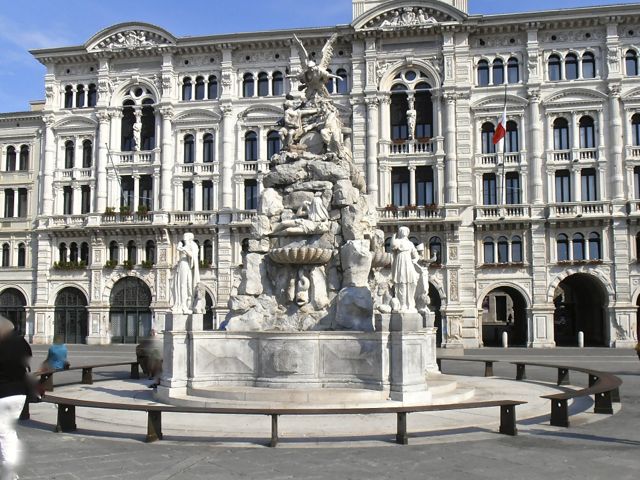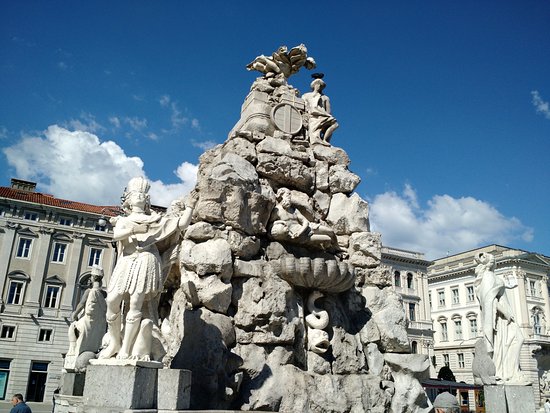Fountain of the Four Continents
One of the most characteristic and ancient elements of today's Piazza Unità d'Italia, formerly Piazza San Pietro and Piazza Grande, is the Fountain of the Four Continents, the work of Giovanni Battista Mazzoleni from Bergamo.
It was built between 1751 and 1754 as the main city outlet for the aqueduct wanted by the Empress Maria Teresa and built with the proceeds of the duty on fish. Coeval and with the same purpose, the Giovanin Fountain in Piazza Ponterosso were also erected in 1753 and the Neptune Fountain in Piazza della Borsa in 1755.
The intent of the authorities was to communicate the idea of a thriving commercial city, whose fortune was due to the concession of the Free Port by Charles VI and the development policies implemented by Maria Theresa of Austria.
There was heated discussion about this work, both for its appearance, considered a "rough and unseemly mass of stones", and for the state of neglect in which it was left several times. The City Council approved its demolition on May 29, 1925, this was avoided only thanks to the strenuous defense of the monument by the major Trieste artists of the time. The following year an important restoration was entrusted to the sculptor Marcello Mascherini.
In September 1938 (on the occasion of the Comitium that Benito Mussolini would have conducted announcing the promulgation of the racial laws) the fountain was completely dismantled and its stones were admitted to the Civic Garden of San Giusto.
The fountain was reassembled, in a decentralized position from the original one, only in 1970, thanks to the interest of the painter Cesare Sofianopulo. On 10 October 2000, the rearrangement of the entire square made it possible to relocate the fountain in line with the municipal building, or rather in its original position.
Description
On top of a sort of pyramid, a winged figure hovers announcing to the world the fame of Trieste, a city-emporium with a commercial vocation, alluded to by crates, barrels, bales of cotton and ropes present.
At the four corners of the basin there are four statues that symbolize the then known continents (Europe, Asia, America and Africa).
Between the continents we can see some reclining figures, allegories of the main rivers present in them (Danube, Ganges, Mississippi and Nile presented with the head veiled because at that time the sources were unknown). These, from some wineskins, pour water
in the shells below. Below the shells there are some dolphins, from whose mouths the water gushed into the capacious mixtilinear tanks.
In conceiving this work, it was necessary to solve the problem of inserting the fountain in a small square with a strongly elongated rectangular shape and surrounded by stylistically different architectural realities: the English baroque was preferred to the magniloquent language characteristic of the Italian and French baroque.
Curiosity
Several acts of vandalism have affected the monument over the years causing damage to the arms of the statues of America and Asia and to the head of Africa (which was completely detached, and damaged but fortunately left in place on the night of May 15, 2008) . The last episode, the most serious, took place in October 2015 when a man suffering from psychic problems climbed the monument and performed it in several places, particularly damaging the figure of the angel.
The monument was the protagonist of happy celebrations, such as the inauguration of the new Lazzaretto di Santa Teresa, on the occasion of which, on July 30, 1769, the water dispensing mechanism was modified so that red and white wine gushed from the fountain.










